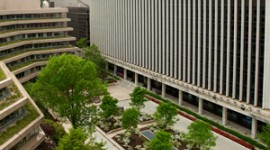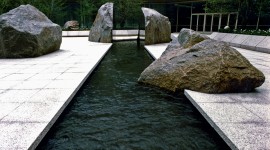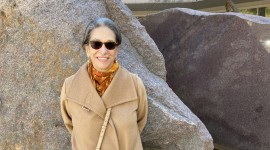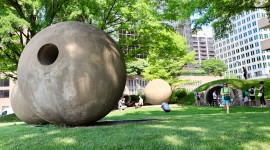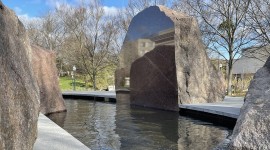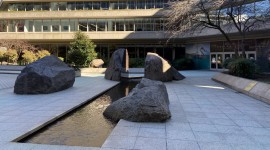From Marabar to Sudama – A Q&A with Artist Elyn ZImmerman
On April 4, 2023, Marabar, the site-specific installation by artist Elyn Zimmerman originally located at the National Geographic Society (NGS) headquarters in Washington, D.C., will be unveiled in a new location, American University, in a new configuration, and with a new name, Sudama. This is a far cry from March 31, 2020, when The Cultural Landscape Foundation (TCLF) announced Marabar had enrolled as a Landslide site because NGS planned to demolish the widely acclaimed work as part of a campus renovation.

Zimmerman had been resigned to the pending loss of the work when TCLF reached out in mid-March 2020 offering to advocate on its behalf. TCLF was able to get the city’s Historic Preservation Review Board (HPRB), which had approved the campus renovation on August 1, 2019, to reopen the case and revisit its decision. TCLF successfully pointed out that renovation plans submitted to the HPRB hadn’t been properly illustrated Marabar and therefore the HPRB members didn’t realize their vote would lead to the installation’s demolition. On a parallel track TCLF solicited more than two dozen letters of support for saving Marabar from leaders in the art world, landscape architects, architects, journalists and others.
While the HPRB did reopen the case, they ultimately concluded they didn’t have jurisdiction over the work. Nevertheless, NGS ultimately came forward and offered to relocate the work at their expense and under Zimmerman’s direction. The artist considered several locations and concluded the American University campus was the proper new home. She also decided the work would have a new configuration and name.

In a recent Q&A with TCLF, reflected on the past three years and the new life of Marabar.
What did you think when TCLF reached out to you about re-opening the Marabar case?
It was a big surprise. In 2019 I was contacted by an administrator at the National Geographic Society (NGS) and informed of the pending “removal” of Marabar. At that time I learned that the Disney Corporation now was partner to NGS and was interested in constructing a new building on the site of the existing plaza and garden, necessitating the removal of Marabar. I tried to discuss options with them that would preserve Marabar but was not successful and I was not prepared to engage in a legal battle.
I didn’t realize – but TCLF did – that the new NGS architects did not represent their intentions about removing Marabar to the D.C. Historic Preservation Review Board; this omission constituted a reason for the Board to initiate a new review before issuing any building permits.

As part of TCLF’s strategy to illustrate the work’s significance, TCLF solicited dozens of letters from experts. What did it mean to you when you read the testimonials that were submitted?
It was very touching and emotionally supportive. Marabar was the first large outdoor project I did (started in 1981 and dedicated in 1984). I was always proud of the project and considered it one of my best works. So it was heartwarming to learn – from the letters and the press – that other artists and design professionals felt it was an historically important project and that after 40 years should be given more respectful consideration.

When you learned that Marabar would not be destroyed but instead relocated and reimagined, what did you think?
This was not a solution that I first considered. The shape of the pool, it’s length and width; the location of seven large stone pieces in the garden surrounding the plaza; the location and relationship of the rough/polished very large stones pieces around the pool had all been carefully planned as site specific to the NGS plaza.
I could not see how these pieces could just be moved to another site. It wasn’t until I realized that I could take the rock pieces and rearrange them to accommodate another site location and could also change the size and shape of the pool that I became comfortable about relocating the ‘elements’ of what had been Marabar and create a new project that responded to a new site.

Once you saw the proposed site how did that inform your approach?
I visited a number of potential locations for a new home for the elements of Marabar. When I saw the site at American University I was convinced that a new interpretation could be successful. Instead of the urban location of Marabar, tucked in between large NGS buildings and with a granite paved plaza, the new project would be in an open, elevated, sylvan space surrounded by trees and landscaping. The size and shape of the pool was changed to work with the new site. The landscape rocks were positioned around the existing plantings and trees. The polished and rough large rocks - the core of Marabar - were positioned slightly differently around the new pool. Although reminiscent of Marabar, the new setting, and a thorough cleaning and repolishing of worn spots after 40 years made the piece look new and unique so it needed a new title.
In 1981 the title Marabar was inspired the description in E.M. Forster’s book A Passage to India of one of the many caves in India that were carved 3000 years ago out of natural solid rock. Forster had visited the Barabar Caves in northeast India and changed the location’s name to Marabar for the novel. His book describes one cave in particular - Sudama. It’s entered through a rectangular passageway that leads to a high, long, barrel-vaulted space with ‘mirror’ polished walls and arched ceiling. The polish is to support the extraordinary acoustics experienced in the space that was used for centuries by religious devotees for meditation and chanting.
What does it mean to see Sudama now installed at American University?
In some other countries art works are endowed with droit moral - a French term meaning the ability of creators to control the eventual fate of their artwork…be it visual art, written works, music etc. It protects artistic integrity and prevents the alteration or destruction of a given work of art.
The United States has laws that protect the economic value of art works, but not the integrity of the art works.
Once the conversation about Marabar changed, due to the efforts of TCLF and others, and its destruction was avoided. The National Geographic Society and I worked together with a team of experts to enable the transition to proceed. It is something of small miracle that droit moral applied to Marabar led to its preservation and reconstruction as Sudama.




